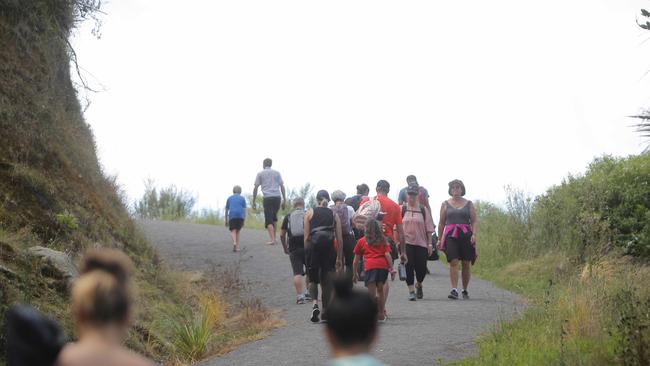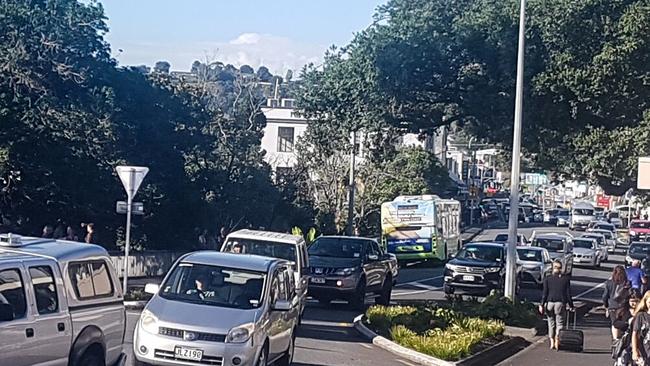NZ tsunami alert lifted but coastal areas at surge risk after 8.1 quake off Kermadec Islands
New Zealand’s tsunami alert has been downgraded to a beach and marine threat but scientists warn it may be upgraded again.

New Zealand’s tsunami alert has been lifted after GNS Science advised the largest waves had passed.
However scientists warned NZTV the alert could be upgraded again as aftershocks from the earlier, massive 8.1 earthquake continue.
1ï¸âƒ£3ï¸âƒ£ hours of seismic activity in 1ï¸âƒ£3ï¸âƒ£ seconds
— NIWA Weather (@NiwaWeather) March 5, 2021
Dozens of quakes have caused shaking around NZ today…
Have a watch â–¶ï¸
Data: @gnssciencepic.twitter.com/CqjTgmkqY0
The agency downgraded the threat level of areas under a Land and Marine Threat to Beach and Marine Threat. All evacuated people were told they could return but must remain off beach and coastal areas.
The agency said on its website: “GNS Science has advised that the largest waves have now passed, and therefore the threat level is now downgraded to a Beach and Marine threat for all areas which were previously under Land and Marine threat.
“All people who evacuated can now return.
“The advice remains, for all areas under Beach and Marine threat, to stay off beach and shore areas”.
Surges arrive on east coast
Surges have started to arrive on the east coast of the North Island, as residents report seeing the water recede - the first sign of a tsunami - after a swarm of strong earthquakes struck the area this morning.
Modelling shows a potential land threat. “We classify that as one metre and above for much of the north coast of the North Island, and then there is the beach and marine threat...
— Jamie Morton (@Jamienzherald) March 4, 2021
NZ media reported some dramatic surges, with residents of Tauranga, on the east coast, and Tutukaka in Northland tweeting videos and pictures as they arrived. They are expected to continue for some hours.
#TSUNAMI rolling into Tokomaru Bay #EQNZ#NewZealandpic.twitter.com/g0ZBq8Wpcy
— Mount Maunganui (@Mt_Maunganui) March 4, 2021
The first waves are small but scientists warn that larger waves arrive later as they build up out to sea and rush ashore.
JUST IN - Water drawn back as Tsunami approaches, Northland, New Zealand#tsunami#newzealandpic.twitter.com/7hrid7Ep7l
— Insider Paper (@TheInsiderPaper) March 4, 2021
Bill Fry, GNS seismologist, told reporters the waves would be around one to three metres above tide level. He said they moved quickly across the ocean but as they reached shallower waters they would get slower and taller.
First surge from tsunami in NZ pic.twitter.com/Fqhe97spzu
— nigel murch (@nigelmurch1) March 4, 2021
Elsewhere in the country, residents were reporting seeing the water receding – the first sign of a tsunami before the water comes rushing back in.

Shaun Tepania, principal of the coastal Whananaki school in Whananaki, north of Whangarei told the NZ Herald he could see the tide going out when it was supposed to be incoming.
“We’re sitting up overlooking the estuary. It all seems okay for the time being, but the tide is going out when it is supposed to be coming in,” he said.
Tide here going out quickly @tsunami nz pic.twitter.com/awWFVZfvmQ
— Laani (@Laani85440897) March 4, 2021
Whangarei resident Adam Janes told the NZ Herald the water appeared to have lowered in some areas.
“I was just leaving the port and caught a glimpse of the main town basin and I have never seen it that low. You could see the rocks in the channel area … even at low tide you’d never see that,” he said.

Susan Eng, in Tauranga, told the Herald there was “definitely disturbance” to the city’s Waikareao Estuary.
“I noticed the tide started coming in a lot quicker than it normally would. There’s rippley stripes on the estuary [but] there’s only a little bit of breeze. It definitely looks different,” she said.
In the far north, Dr Anna Barry tweeted a picture of water receding at the Karikari peninsula. “Sea calm but receding up on Karikari peninsula as we wait for the big wave,” she wrote.
Sea calm but receding up on Karikari peninsula as we wait for the big wave. #nztsunamipic.twitter.com/ktv8wz8QYr
— Dr Anna Barry (@dramb83) March 4, 2021
A tsunami warning was earlier issued for New Zealand coastal areas on both the North and South Island as well as Norfolk Island after three severe earthquakes hit off the coast of New Zealand this morning.
Sirens activated around New Zealand coasts as evacuation is ordered due to tsunami alert issued after strong 8.0 magnitude earthquake.#BREAKING#NewZealand#earthquakepic.twitter.com/qvMrOE8ElO
— Prakash Lalit (@PrakashLalit3) March 4, 2021
Residents on the west coast of the North Island from Cape Reinga, the country’s northernmost tip, to Ahipara and on the east coast from Cape Reinga to Whangarei, from Matata to Tolaga Bay including Whakatane and Opotiki have been told by Civil Defence to move to high ground “immediately”.
The same warning was given to residents of Great Barrier Island, off Auckland. A beach and marine warning was also issued for Wellington, the capital, and Auckland, the country’s largest city although residents were told there was no need to evacuate. Marine alerts were also issued for the north and west coasts of the South Island.
Don't go for a swim.
— A Hobbit (@AHobbitLady) March 4, 2021
Basically green means marine and beach threat. So don't go into the waters. Including rivers. pic.twitter.com/4UlC769xPk
Sea calm but receding up on Karikari peninsula as we wait for the big wave. #nztsunamipic.twitter.com/ktv8wz8QYr
— Dr Anna Barry (@dramb83) March 4, 2021
Minister for Emergency Management Kiri Allan said the alert would probably remain in place most of the day.
The first waves were due to hit Lottin Pt, on NZ’s East Cape at around 8am (AEDT) and are expected to arrive at Norfolk at 9am (AEDT).
TSUNAMI ADVISORY: BEACH AND MARINE THREAT. Strong and unpredictable currents expected for the Wellington Region's West Coast as far south as MAKARA and the East Coast as far south as LAKE FERRY. Stay away from beach + marine areas. There is no need to evacuate at this stage. https://t.co/R2wNLAugII
— Wellington Region Emergency Management Office (@WREMOinfo) March 4, 2021
The Bureau of Meteorology issued an updated warning for “dangerous” water activity on Norfolk Island occurring from 10am (9amAEDT) this morning.
The warning for the marine environment says there is the “possibility of dangerous rips, waves and strong ocean currents, and some localised overflow onto the immediate foreshore.”
The activity will persist for several hours.
TSUNAMI WARNING: The first waves may reach NZ in the areas around Lottin Point at approximately 9:49am NZDT. Tsunami activity will continue for several hours and the threat must be regarded as real until this warning is cancelled. More info at https://t.co/ccVFYQQoBr
— National Emergency Management Agency (@NZcivildefence) March 4, 2021
***TSUNAMI UPDATE***
— Bureau of Meteorology, Australia (@BOM_au) March 4, 2021
A marine #tsunami warning for #NorfolkIsland has been reissued to correct for local time. Possible impacts from 10am local time (NFDT) following magnitude 7.9 #earthquake north of #NZ.
Latest info here:https://t.co/PsiUMeQNZHpic.twitter.com/Q1cPQvHwLa
New Zealand authorities have said there is a danger to swimmers, surfers, people fishing, small boats and anyone in or near the water close to shore near these areas.
A 7.2 magnitude earthquake hit the North Island at 2am, 100km east of Te Araroa off the coast.
The quake triggered a tsunami warning for the northeast of the country, with people in certain areas of the North Island told to move to high ground.
TSUNAMI WARNING issued following Kermadecs earthquake. People near coast from the BAY OF ISLANDS to WHANGAREI, from MATATA to TOLAGA BAY, and GREAT BARRIER ISLAND must MOVE IMMEDIATELY to nearest high ground, out of all tsunami evacuation zones, or as far inland as possible
— National Emergency Management Agency (@NZcivildefence) March 4, 2021
Following this, a magnitude 7.4 earthquake hit near the Kermadec Islands, 1000km northeast of New Zealand’s mainland at 6.41am.
At 8.30am (6.30am AEDT), the severe 8.1 magnitude earthquake hit the same islands, which was at a depth of 19.4km.
3 very strong earthquakes have struck near New Zealand within 6 hours of one another. The 8.1 #earthquake has prompted a #Tsunami watch for Hawaii. The potential threat is still being evaluated there and for the west coast of North America by the Pacific Tsunami Warning Center. pic.twitter.com/yaaanJLw2M
— Ed Piotrowski (@EdPiotrowski) March 4, 2021
At 7.45am a fourth, 6.5 quake struck off Kermadec. at a shallow depth of 10km.
Notable quake, preliminary info: M 6.5 - Kermadec Islands region https://t.co/vs7njZKqrL
— USGS Earthquakes (@USGS_Quakes) March 4, 2021
A tsunami warning has also been issued for Norfolk Island in Australia.
No waves have been observed that may threaten Australia but residents have been asked to monitor the situation.
“The Joint Australian Tsunami Warning Centre is closely monitoring the situation
and will advise immediately if there is cause for concern,” a statement from the Bureau of Meteorology said this morning.
A #Tsunami Watch has been issued for #Australia following an 8.1 magnitude earthquake near the Kermadec Islands north of #NZ.
— Bureau of Meteorology, Australia (@BOM_au) March 4, 2021
There is a potential tsunami threat to #NorfolkIsland in the coming hours.
Further details to come https://t.co/Yu49nnOJMipic.twitter.com/w27RoLhVsk
Tsunami alerts have been issued for NZ, Fiji, Cook Islands, American Samoa, Pitcairn Islands, Wallis and Futuna, Tonga, Niue, New Caledonia, Solomon Islands, French Polynesia, Ecuador, Colombia, Costa Rica, Nicaraga, Panama, Peru and Mexico and a warning for Hawaii.
No tsunami has yet been seen, but residents of these areas have been asked to continue to watch the situation.
No damage or injuries were reported from the earlier quakes.



To join the conversation, please log in. Don't have an account? Register
Join the conversation, you are commenting as Logout